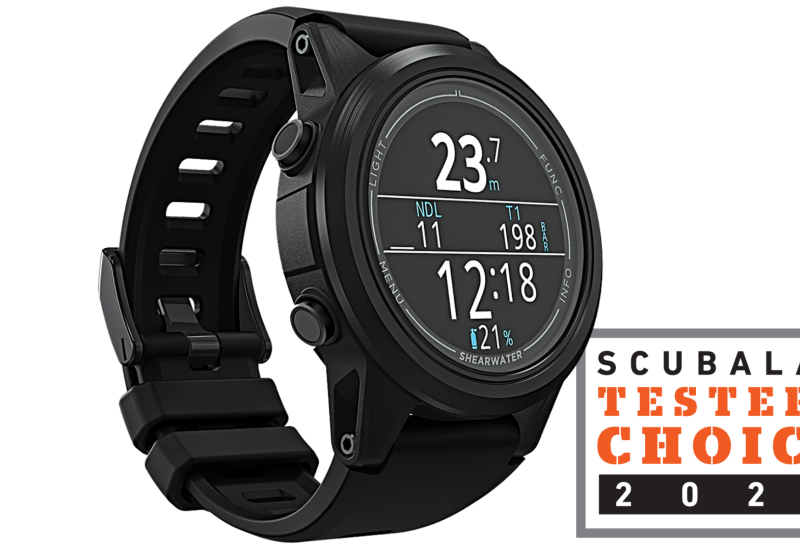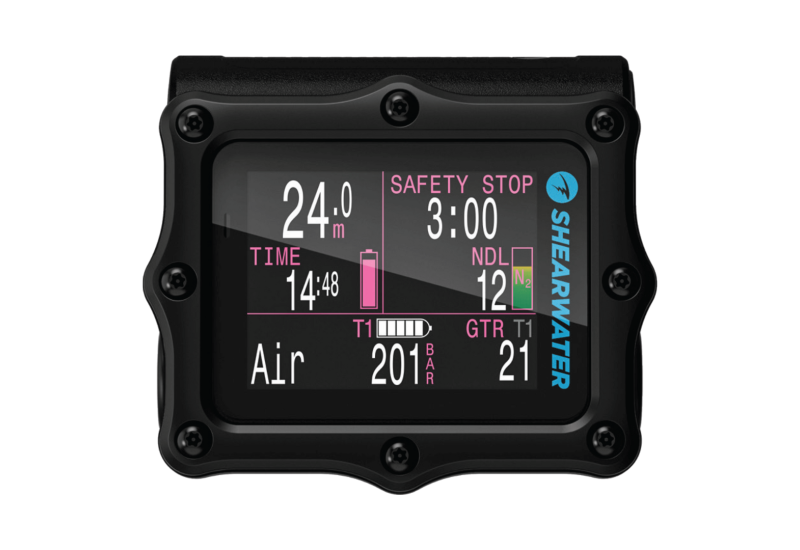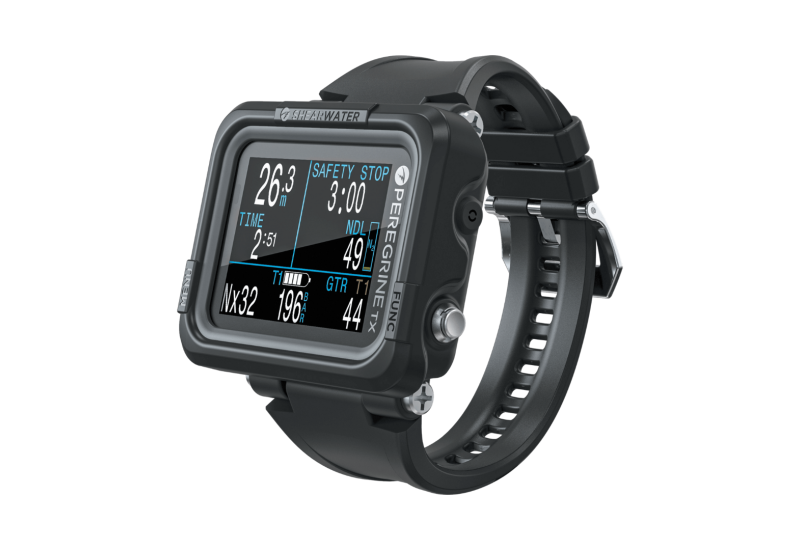Crunching the Numbers

August 2004
By John Brumm
Photography by Paul Nurnberg
Dive Computers Reviewed in This Article
| AERIS Atmos Elite CITIZEN Aqualand Nx DACOR Darwin Air GENESIS React Pro GENESIS Resource Pro MARES M1 RGBM MARES Nemo | OCEANIC Atom 1.0 OCEANIC VT Pro OCEANIC Veo 250 SHERWOOD Profile SUUNTO Gekko TUSA IQ-700 Hunter TUSA IQ-800 |
Since the introduction of the Orca Edge back in the early 1980s, dive computers have changed the face of diving. Few serious divers go in the water without one, and why should they? By continually calculating your no-decompression status during a dive, dive computers allow you more bottom time than do dive tables. They also monitor your ascent rate, record information on your dive and help you get out of unplanned decompression obligations--all functions that help you dive safer.
To review this year's crop of new computers, we first ran them through a three-dive profile at the USC hyperbaric chamber on Catalina Island, Calif. There we gathered data on each computer's relative liberalism or conservatism and found some surprising differences in how they compute no-deco limits.
Of course, how a computer goes about giving you information is also important. For the ergonomic evaluation, we put them in the hands of our seasoned team of test divers during a week of rigorous diving. Their mission: evaluate how well these computers provide and present critical dive data. Again, there are some surprising differences, and you'll find the divers' comments in the following reviews.
Dive Computers in Review
Presented in alphabetical order, by manufacturer.
AERIS Atmos Elite
||
|---|
|

|
| AERIS Atmos Elite|
The newest member of the Aeris family of dive computers is the air-integrated Atmos Elite. It uses a remote transmitter that screws into your reg's first stage, eliminating the need for a high-pressure hose. The Atmos Elite reads tank pressure to 5,000 psi in five-psi increments.
The low-profile wrist-mounted display provides a large face with good-sized primary data digits and smaller but still easy-to-read secondary data digits. The computer uses lots of graphics and makes generous use of green-yellow-red bars for nitrogen loading, oxygen loading and ascent rates.
The Atmos Elite uses a relatively liberal algorithm that allows more bottom time than many other computers. You can't program it to be more conservative, but backing off a few diamonds on the three-color nitrogen loading bar is an effective way to create your own safety cushion.
Overall, test divers loved the Atmos Elite, giving it thumbs up for its ability to provide easy-to-read data at depth. One diver praised the Elite for its "logical arrangement of data and practical logging capabilities." It comes with a padded storage box, and its software is upgradeable, so any future changes in algorithms can be downloaded through the computer's external calibration port.
CITIZEN Aqualand Nx
||
|---|
|

|
| CITIZEN Aqualand Nx|
The Aqualand Nx is a combination digital wristwatch and dive computer. As a computer, test divers described the Aqualand Nx as easy to use, even for neophytes, with "straightforward functions." It's the only rechargeable computer of this group. We found the charge lasts only a few days, but it's easy to top off the batteries in a couple hours.
In spite of its very small screen--it's a watch, after all--Citizen did a good job of providing bold data digits within a limited space. Of course, they could have eliminated a few of the more obvious graphics. "You don't need a scuba diver icon to tell you you're under water," reported one of our test divers.
Other testers weren't happy about the Aqualand's lack of a practical backlight, and the fact that in nitrox mode it automatically resets the fo2 setting to a default of 50 percent just 30 minutes after the last dive. Still, this snappy computer earned unanimous attaboys for a lot of technology loaded into a compact package.
This computer uses a DCIEM algorithm, which in our tests was conservative at maximum depths, but liberal on ascents. The Aqualand Nx comes with a hard carrying case, a charger and software.
DACOR Darwin Air
||
|---|
|

|
| DACOR Darwin Air|
The Dacor Darwin Air is a console computer that in many ways is one of the simplest, most user-friendly computers in this group. It runs on two AAA batteries that are falling-down simple to replace, it has the bar-none best backlight going (you can activate it for 15 seconds or keep it on full-time). The screen uses multicolor prompts and a labeling system that makes it super simple to tell what mode you're in. There are also a couple of LED lights and audible alarms to help keep you focused on the tasks at hand.
But when you include both the main screen and the tank pressure screen (which reads to 5,150 psi in 10-psi increments) you can find yourself with a bunch of numbers to deal with. Most of them are labeled, but the labels are tiny and can be hard to see at depth.
Consequently, the Darwin Air generated the most polarizing reactions from test divers. On the plus side were comments like, "The numbers are not large, but they're nicely organized and readable"; "very comprehensive post dive info"; and "the visual warning lights are a big plus." On the negative side, divers complained about too many numbers creating a confusing screen. As one diver put it, "I look at this display and think, 'where the heck am I?' I've got nine numbers to deal with here." Another diver commented: "I can't tell which number is which. How deep am I? Is it the large number or the teensy number? I can't tell."
The Darwin Air uses a variation of the RGBM algorithm. While this is the most conservative algorithm in this test group, divers who like an even greater safety margin can program in additional conservatism by adjusting the altitude setting. This computer also features a disconnect fitting so you can detach it from the high-pressure hose and take it with you.
GENESIS React Pro
||
|---|
|

|
| GENESIS React Pro|
This simple dive computer can be mounted in a console, strapped to your wrist or attached to a retractor. Its green-yellow-red color bars are a bit hard to see at depth, but its display is very intuitive, and there are three data screens in dive mode. The main screen provides dive time remaining and current depth, the first alternate screen gives you bottom time, max depth and some oxygen data if you're diving nitrox, and the second alternate screen shows water temp, time of day and a bit more nitrox data, if applicable.
The upside to splitting up data like this is that each screen is uncluttered and easy to read. On the downside, you might find yourself switching screens more than you'd like in order to access basic dive data. In spite of the screen shuffle, test divers felt it was easy to follow the data trail.
Test divers also liked the audible ascent alarm and deemed the React Pro easy for planning and checking logs. However, a number of divers felt the plastic screen guard made the computer difficult to read on the surface after the dive. This guard is easy to remove.
GENESIS Resource Pro
||
|---|
|

|
| GENESIS Resource Pro|
If you like to shop price, if you don't dive nitrox or if you aren't so familiar with computers, take a look at the Genesis Resource Pro. Eschewing such frills as audible alarms, nitrox capability and a PC interface, this one-button-activated computer offers solid computing in a simple package that incorporates intuitive green-yellow-red bars to monitor no-decompression limits (NDLs) and ascent rates as well as helpful graphics. In dive mode there are two screens: the main screen shows NDLs and current depth; push the button and you get bottom time and max depth.
The Resource Pro earned very good comments for ease of accessing data at depth. Said one test diver, "I loved this computer. It was very simple to use and I loved the diagram for max depth. It easily gave me the info that was most important to me through the entire dive." Another test diver concurred: "This computer is easy to use and easy to read. I like its simplicity."
The only complaint leveled against the Resource Pro had to do with its continual scrolling in surface mode, which can be annoying when you're trying to get back to the main screen.
MARES M1 RGBM
||
|---|
|

|
| MARES M1 RGBM|
Like the Dacor Darwin Air, the Euro-style Mares M1 RGBM is good-looking and user-friendly, from its simple battery loading arrangement to a superior backlight system that allows you to see the light either for 15-second intervals or the entire time, your choice. It also uses a brand-new RGBM algorithm that provides for a deeper safety stop ceiling than other dive computers, and allows you to easily program in additional levels of conservatism via two large control buttons.
But also like the Darwin, the Mares takes some getting used to. Though it has a relatively simple screen with readable data digits, the words labeling each number are minuscule and can virtually disappear at depth, depending on how good your eyes are. Also, the words and icons on the bottom of the screen that let you know what mode you're in are tiny. Consequently, test divers found it took a couple of dives to get accustomed to the presentation. The owner's manual is fairly large and written in six languages.
OCEANIC VT Pro
||
|---|
|

|
| OCEANIC VT Pro|
The VT Pro is Oceanic's newest "hoseless" version of an air-integrated dive computer. With its low-profile wrist display and large screen, this easy-to-use computer was a favorite among test divers. It offers five screens in the dive mode. Green-yellow-red color bars let you easily monitor your nitrogen loading and ascent rates, as well as oxygen loading if you're diving nitrox. What's more, it offers an additional "air time remaining" color bar that provides a graphic representation of how much time you can remain at your present depth and then, following a safe ascent, surface with a pre-determined reserve of air.
Using the most liberal of the algorithms, the VT Pro has a programmable audible alarm that sounds when you reach a pre-determined point on the nitrogen loading color bar. This makes an easy system of providing a safety cushion that much easier. Said one test diver, "I really like the idea of having an air-integrated computer worn on the wrist, so all critical info--including air pressure---is in one place." Another test diver was partial to the choice of screens in dive mode: "I loved this computer. Easy to read, easy to use, lots of good data, and the important info is readily available."
Most of our test divers had no problems with data transmission via the wireless transmitter, regardless of where they positioned the wrist unit. However, one diver who likes to cruise the reefs with his arms folded tightly under his chest, reported that he occasionally lost tank pressure data. When he unfolded his arms, the unit re-acquired the signal relatively quickly. The VT Pro reads tank pressure to 5,000 psi in five-psi increments. It comes with a padded storage box.
OCEANIC Veo 250
||
|---|
|

|
| OCEANIC Veo 250|
The Veo 250 has been around for a while in Australia, Japan and Europe, but is only now being sold in the U.S. It's similar in shape and size to the VT Pro, providing a low profile on the wrist, and it uses the same algorithm, but it isn't air-integrated, nor does it have some of the VT Pro's other features. The green-yellow-red color bars don't pop as well as the VT Pro's either. But the computer does reflect Oceanic's smart use of graphics as well as its penchant for large uncluttered screens with big bold data digits that are easy to read under water.
Overall, test divers liked the performance and presentation of data of the Veo 250 via its four dive mode screens. Commented one diver, "The alternate screens are easy to understand and to access at depth, and I like the simple logbook function on the surface." However, this same diver found the clear plastic screen protector "a bit hard to see through right after you get out of the water." These protectors snap onto the screen face and are easy to remove. Another test diver found it very easy to program in personal preferences: "It's very intuitive. Button controls are easy to use, putting all relevant data right at hand."
{mospagebreak} SHERWOOD Profile
||
|---|
|

|
| SHERWOOD Profile|
Sherwood's Profile is a keep-it-simple dive computer incorporating a single push-button control, green-yellow-red bar graphs and good-sized numbers set in an orderly display. While universally lauded as an efficient, easy-to-use dive computer, this simplicity appealed to only half the test divers--in particular, those who aren't that familiar with computers.
The Profile has an owner's manual that is simple and straightforward and easy even for the neophyte computer user to understand. The computer itself was described as "very functional." One test diver, who prefers simplicity, added, "This is a very readable computer. I found it very easy to understand, even on the first dive."
But the more computer-savvy divers felt that while the Profile performed well as a basic computer, it was just too limiting for their tastes. Said one such diver, "This is a simple, easy-to-use computer, but the one-button control is just not enough." Preferring a computer with more programming capability, he added, "For me, this would be a really good backup computer."
SUUNTO Gekko
||
|---|
|

|
| SUUNTO Gekko|
The Gekko is based on Suunto's popular Vyper and Cobra dive computers, without a number of their features and at a much lower price. What you get with the Gekko is a wafer-thin, well-laid-out display with big bold numbers, helpful graphics and green-yellow-red color bars to simplify data monitoring. What you don't get is a PC interface or an electronic backlight function. To provide illumination you can charge the computer's phosphorescent LCD display by shining a dive light on it.
Contributing to what test divers considered to be an excellent data screen both on the surface and at depth, the Gekko lets you know exactly what mode you're in by plainly telling you-- "history," "memory," "nitrox," etc. appear prominently in the lower corner of the screen, a huge convenience. Grouping similar functions into a single section also simplifies the menu system, creating a more intuitive computer requiring fewer button pushes to get where you want to go.
This is the most programmable computer of the group, allowing you to adjust for three altitude ranges as well as three personal preference ranges. This will make a computer that already leans toward the conservative even more so.
As one test diver commented, "This is a great, safe, easy-to-understand computer. Simple for the beginner, but with all the features that a pro might need." Another diver added, "An outstanding computer, simply no complaints--except for the lack of a backlight."
TUSA IQ-700 Hunter
||
|---|
|

|
| TUSA IQ-700 Hunter|
Tusa's IQ-700 Hunter is another computer that uses a well-designed display with "dive," "plan," "log" and other prompts to let you know what screen you're working in. The computer has a large center mode button flanked by smaller buttons that make it easy to navigate through the system. The computer uses green-yellow-red bar graphs, but they are very narrow and difficult to see, especially at depth. Data digits are good-sized and easy to read. A safety factor adjustment allows you to program an additional level of conservatism into your dive.
Overall, test divers liked the Hunter. It garnered positive comments for ease of accessing and reading screens both on the surface and at depth. As one diver said, "It's easy to get the info you need at depth--also easy to read after-dive data. Plus, the manual is easy to follow." Other test divers liked the alarm that sounds as you're about to hit the red NDL zone. However, most test divers griped about having to hold down the button to view the alternate screen. Echoing the sentiments of others, one diver said, "I'd rather just hit the button once and let it go."
Standard Features
Important convenience features once so elusive in dive computers can now be found on virtually every model in this group. For example:
> WATER ACTIVATION. All of these computers will turn themselves on upon hitting the water.
> REPLACEABLE BATTERIES. The lithium batteries used in most of today's computers cost just a few bucks apiece, can be found in most electronics stores and are relatively easy to change. Dacor and Mares make it even easier--their computers use AAA batteries you can buy with your spare change, and their watertight compartments are super simple to access, allowing you to switch out batteries virtually in seconds.
> VARIABLE ASCENT ALARMS. All but the Citizen Aqualand Nx allow for faster ascents at greater depths (60 feet per minute in depths greater than 60 feet), then slow you down as you reach shallower depths (30 feet per minute in depths shallower than 60 feet). The Aqualand Nx allows a uniform rate of 60 feet per minute.
> BACKLIGHTS. All these dive computers except the Aqualand Nx provide some way to illuminate the data screen at night, although some are easier to use and more efficient than others. The Citizen's light function is designed to enhance daylight viewing, only.
> NITROX CAPABILITIES. All but the entry-level Genesis Resource are capable of calculating nitrox mixes up to 50 percent. The Tusa IQ-700 Hunter calculates nitrox mixes to 99 percent.
> AUDIBLE ALARMS. All but the Genesis Resource and Sherwood Profile provide disarmable audible alarms. All of these computers also have some sort of visual alarms, from LED lights to blinking bar diamonds and flashing data digits.
> PC CONNECTIVITY. All but the Genesis Resource and Suunto Gekko offer the ability to download dive data to your personal computer. The Gekko does, however, have a PC port that allows dive shops to zero out the computer between rentals.
> DATE/TIME AND TEMPERATURE. All of these computers provide water temperature. All also offer date, time or both.
The Differences
It's the details that differentiate these computers from each other. For example:
> DATA DISPLAYS. How a computer presents its diving information can make a big difference. Some computers display the most critical data (like NDLs and depth) with the largest digits, followed by the less critical data (like temperature and time) with smaller digits. Other computers use similar sized digits for all data, and on others there seems to be no correlation between the importance of data and the size of digits.
> ALGORITHMS. A computer's algorithm determines its liberal or conservative leanings. Conservative algorithms limit the amount of time you can spend at depth without putting the computer into deco mode, but increase your safety margin. Liberal algorithms allow more bottom time before going into deco mode, leaving it to the diver to factor in a DCS cushion.
> AIR INTEGRATION. Some of these computers provide tank pressure data, using either a console design that connects to a high-pressure hose, or a "wireless" or "hoseless" system that uses a transmitter screwed into your first stage.
> DATA AND/OR SCREEN ACCESS. Depending on computer, you have from one to four buttons with which to access data, program preferences or switch screens. In most cases, the more buttons a computer has, the easier it is to use.
> COLOR HIGHLIGHTS AND/OR GRAPHICS. Nitrogen-loading and ascent rate bars using green, yellow, red color schemes make information much easier to read and understand. Graphics also draw attention to critical data, and word or icon prompts allow you to immediately discern what mode you're in.
Fashionably Late
Here's a first look at three new computers unavailable during our tests but now hitting the U.S. market. Look for full reports in a future issue.
||||
|---|---|---|
|

|
| MARES Nemo|
> MARES Nemo. This stylish, Euro-designed dive computer/wristwatch combo is available in a brushed stainless-steel or titanium casing with a composite rubber wristband. It uses Mares' new RGBM algorithm and it's suited for both air and nitrox mixes.
||||
|---|---|---|
|

|
| OCEANIC Atom 1.0|
> OCEANIC Atom 1.0. Oceanic's first wristwatch/computer combo is air-integrated, offers eight different screens and can be programmed for up to three nitrox mixes. OceanLog PC software lets you download dives and upload settings.
||||
|---|---|---|
|

|
| TUSA IQ-800|
> TUSA IQ-800. The sleek IQ-800 DC-Sapience generates a lot of buzz, thanks to its uncluttered layout and unique vibration warning function, similar to what you'd find on a cellular phone.
Liberal or Conservative?
How your computer's algorithm affects your bottom time
By John Francis
Our dive computer tests don't stop with the size of the buttons and the readability of the displays. We also test the information they give you about your no-decompression limits (NDLs) because computers can differ significantly on the exact same profile.
To test these differences, we put all 11 dive computers in the USC Hyperbaric Chamber on Catalina Island and ran them simultaneously on a three-dive profile designed to represent a typical day of multilevel dives within recreational limits.
The first dive, for 51 minutes, went to a maximum depth of 100 feet. After a one-hour surface interval we made a second dive of 44 minutes to a max depth of 70 feet. An hour-and-a-half surface interval followed before the third dive, 41 minutes to a max depth of 60 feet. Just to make it interesting, the second dive included a reverse profile--five minutes at 40 feet, four minutes at 60 feet, then five minutes at the max depth for 70 feet. On the ascent we had our "divers" spend six minutes at 60 feet and seven minutes at 40. Ascent rates did not exceed 30 feet per minute.
Our liberal-vs.-conservative charts note the minutes of no-deco time each computer allowed at specific moments in each dive. These differences are the result of the algorithms used to calculate NDLs.
Are the most liberal computers reckless? Are the most conservative paranoid? There's no way to be sure, given the theoretical nature of decompression and individual factors such as fitness, cold, exertion levels and hydration. Ultimately, you must decide what constitutes a safe profile and build in safety margins.
Algorithm Soup
An algorithm, in this context, is your dive computer's program. It's the complex mathematics behind someone's theory of how decompression works. The computers in this review use four base algorithms--usually tweaked and modified to varying degrees by manufacturers--based on four different theories of how a diver absorbs and eliminates inert gases.
THE BASE ALGORITHM: Haldanean
Based on the work of J.S. Haldane, the pioneer of decompression theory, these algorithms have been modified numerous times over the years and remain the most widely used in diving. Haldane's theory grouped the body's thousands of different tissues into theoretical tissue compartments, each with a different rate for absorbing and releasing inert gas. He also believed that gas was always released at the same rate at which it was absorbed. The theory does not account for the presence of tiny "silent bubbles" formed during ascent that can slow off-gassing, so Haldanean algorithms, unless specifically modified, tend to be very liberal in adding no-decompression time during ascents.
The Computers: Aeris Atmos Elite, Genesis React Pro, Genesis Resource Pro, Oceanic VT Pro, Oceanic Veo 250, Sherwood Profile.
The Results: In our tests, these six computers allowed the most consistently liberal no-deco times from start to finish and consistently added no-decompression time during ascents--even after the reverse profile.
THE BASE ALGORITHM: DCIEM
Developed by the Canadian Defense and Civil Institute of Environmental Medicine (DCIEM), this algorithm is unusual because it assumes only four tissue compartments and because it assumes that dissolved gas passes from your blood to your fastest tissue, and from it to the next fastest, and so on. Haldane and other theories assume gas passes from blood to each compartment directly.
The Computer: Citizen Aqualand Nx.
The Result: During our chamber dives, the Citizen was very conservative at maximum depths, but also very liberal during the later portions of ascents, sometimes even more liberal than Haldanean computers. On ascent from the reverse profile in Dive 2, it went from the most conservative computer to the most liberal. The Citizen initially subtracted no-deco time (from seven minutes at 70 feet, to three minutes at the 60-foot sampling point), but after seven minutes at 40 feet it was displaying a generous 66 minutes of no-deco time.
THE BASE ALGORITHM: Buhlmann
Swiss researcher Albert Buhlmann added to the Haldanean model the idea behind "M values" developed by Robert Workman. These values represent the theoretical amount of overpressure that tissues can tolerate without forming bubbles. Buhlmann also gave more attention to slower tissues.
The Computer: Tusa IQ-700 Hunter.
The Results: The Tusa consistently staked the middle ground between the most liberal and most conservative computers, but trended to the conservative side. On ascent from the reverse profile, it initially subtracted no-deco time (from 13 minutes at 70 feet to 10 minutes at 60 feet), but then tended to hold steady. On ascent from 40 feet, it added time, but not as rapidly as the Haldanean or DCIEM computers.
THE BASE ALGORITHM: RGBM
The Reduced Gradient Bubble Model (RGBM) algorithm was developed after Doppler bubble research showed that "silent bubbles" unknown to Haldane often form after a dive without causing DCS symptoms. On the theory that these bubbles would be slower than dissolved gas to leave your body, and could even interfere with the outflow of dissolved gas, the algorithm is consistently conservative.
The Computers: Dacor Darwin Air, Mares M1 RGBM, Suunto Gekko.
The Results: These computers started conservative, stayed that way longer during ascents and tended to go even more conservative in their initial response to the reverse profile. At our sample points on the ascent from Dive 2, they had subtracted no-deco time when some of the more liberal computers had added it. One RGBM computer even ran out of no-deco time after a seven-minute stay at 40 feet. Haldanean computers at the same moment allowed 57 minutes, the DCIEM computer 66 minutes. On ascent from 40 feet, they all began to add no-deco time. With an RGBM computer, particularly on a reverse profile, you cannot dive to the edge of the no-deco limits and then assume a modest ascent will buy you more time.

August 2004
By John Brumm
Photography by Paul Nurnberg
Dive Computers Reviewed in This Article
| AERIS Atmos Elite CITIZEN Aqualand Nx DACOR Darwin Air GENESIS React Pro GENESIS Resource Pro MARES M1 RGBM MARES Nemo | OCEANIC Atom 1.0 OCEANIC VT Pro OCEANIC Veo 250 SHERWOOD Profile SUUNTO Gekko TUSA IQ-700 Hunter TUSA IQ-800 |Since the introduction of the Orca Edge back in the early 1980s, dive computers have changed the face of diving. Few serious divers go in the water without one, and why should they? By continually calculating your no-decompression status during a dive, dive computers allow you more bottom time than do dive tables. They also monitor your ascent rate, record information on your dive and help you get out of unplanned decompression obligations--all functions that help you dive safer.
To review this year's crop of new computers, we first ran them through a three-dive profile at the USC hyperbaric chamber on Catalina Island, Calif. There we gathered data on each computer's relative liberalism or conservatism and found some surprising differences in how they compute no-deco limits.
Of course, how a computer goes about giving you information is also important. For the ergonomic evaluation, we put them in the hands of our seasoned team of test divers during a week of rigorous diving. Their mission: evaluate how well these computers provide and present critical dive data. Again, there are some surprising differences, and you'll find the divers' comments in the following reviews.
Dive Computers in Review
Presented in alphabetical order, by manufacturer.
AERIS Atmos Elite

| | AERIS Atmos Elite| The newest member of the Aeris family of dive computers is the air-integrated Atmos Elite. It uses a remote transmitter that screws into your reg's first stage, eliminating the need for a high-pressure hose. The Atmos Elite reads tank pressure to 5,000 psi in five-psi increments.
The low-profile wrist-mounted display provides a large face with good-sized primary data digits and smaller but still easy-to-read secondary data digits. The computer uses lots of graphics and makes generous use of green-yellow-red bars for nitrogen loading, oxygen loading and ascent rates.
The Atmos Elite uses a relatively liberal algorithm that allows more bottom time than many other computers. You can't program it to be more conservative, but backing off a few diamonds on the three-color nitrogen loading bar is an effective way to create your own safety cushion.
Overall, test divers loved the Atmos Elite, giving it thumbs up for its ability to provide easy-to-read data at depth. One diver praised the Elite for its "logical arrangement of data and practical logging capabilities." It comes with a padded storage box, and its software is upgradeable, so any future changes in algorithms can be downloaded through the computer's external calibration port.
CITIZEN Aqualand Nx

| CITIZEN Aqualand Nx| The Aqualand Nx is a combination digital wristwatch and dive computer. As a computer, test divers described the Aqualand Nx as easy to use, even for neophytes, with "straightforward functions." It's the only rechargeable computer of this group. We found the charge lasts only a few days, but it's easy to top off the batteries in a couple hours.
In spite of its very small screen--it's a watch, after all--Citizen did a good job of providing bold data digits within a limited space. Of course, they could have eliminated a few of the more obvious graphics. "You don't need a scuba diver icon to tell you you're under water," reported one of our test divers.
Other testers weren't happy about the Aqualand's lack of a practical backlight, and the fact that in nitrox mode it automatically resets the fo2 setting to a default of 50 percent just 30 minutes after the last dive. Still, this snappy computer earned unanimous attaboys for a lot of technology loaded into a compact package.
This computer uses a DCIEM algorithm, which in our tests was conservative at maximum depths, but liberal on ascents. The Aqualand Nx comes with a hard carrying case, a charger and software.
DACOR Darwin Air
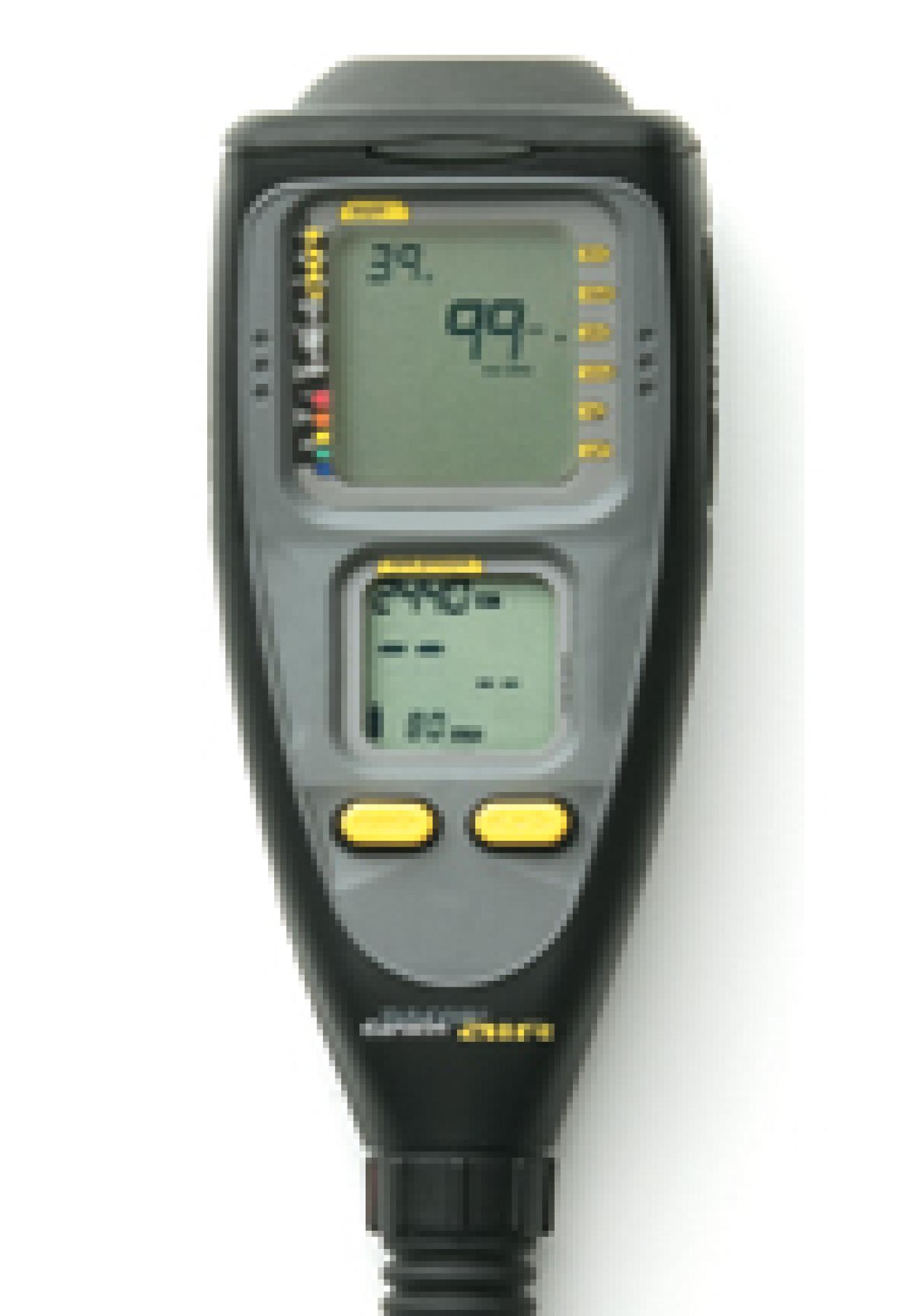
| | DACOR Darwin Air| The Dacor Darwin Air is a console computer that in many ways is one of the simplest, most user-friendly computers in this group. It runs on two AAA batteries that are falling-down simple to replace, it has the bar-none best backlight going (you can activate it for 15 seconds or keep it on full-time). The screen uses multicolor prompts and a labeling system that makes it super simple to tell what mode you're in. There are also a couple of LED lights and audible alarms to help keep you focused on the tasks at hand.
But when you include both the main screen and the tank pressure screen (which reads to 5,150 psi in 10-psi increments) you can find yourself with a bunch of numbers to deal with. Most of them are labeled, but the labels are tiny and can be hard to see at depth.
Consequently, the Darwin Air generated the most polarizing reactions from test divers. On the plus side were comments like, "The numbers are not large, but they're nicely organized and readable"; "very comprehensive post dive info"; and "the visual warning lights are a big plus." On the negative side, divers complained about too many numbers creating a confusing screen. As one diver put it, "I look at this display and think, 'where the heck am I?' I've got nine numbers to deal with here." Another diver commented: "I can't tell which number is which. How deep am I? Is it the large number or the teensy number? I can't tell."
The Darwin Air uses a variation of the RGBM algorithm. While this is the most conservative algorithm in this test group, divers who like an even greater safety margin can program in additional conservatism by adjusting the altitude setting. This computer also features a disconnect fitting so you can detach it from the high-pressure hose and take it with you.
GENESIS React Pro
|| |---|
|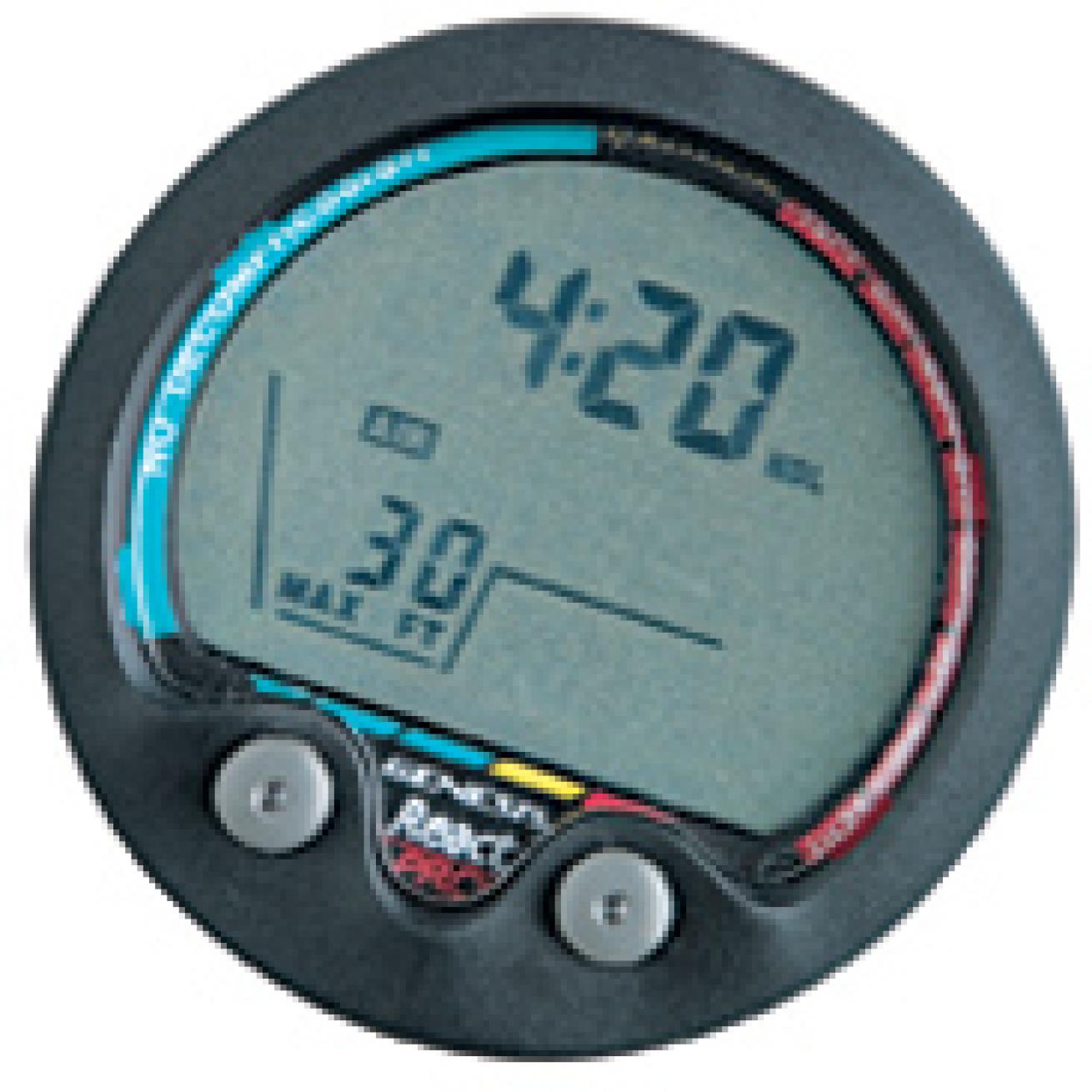
| | GENESIS React Pro|
The upside to splitting up data like this is that each screen is uncluttered and easy to read. On the downside, you might find yourself switching screens more than you'd like in order to access basic dive data. In spite of the screen shuffle, test divers felt it was easy to follow the data trail.
Test divers also liked the audible ascent alarm and deemed the React Pro easy for planning and checking logs. However, a number of divers felt the plastic screen guard made the computer difficult to read on the surface after the dive. This guard is easy to remove.
GENESIS Resource Pro
|| |---|
|
| | GENESIS Resource Pro|
The Resource Pro earned very good comments for ease of accessing data at depth. Said one test diver, "I loved this computer. It was very simple to use and I loved the diagram for max depth. It easily gave me the info that was most important to me through the entire dive." Another test diver concurred: "This computer is easy to use and easy to read. I like its simplicity."
The only complaint leveled against the Resource Pro had to do with its continual scrolling in surface mode, which can be annoying when you're trying to get back to the main screen.
MARES M1 RGBM
|| |---|
|
| | MARES M1 RGBM|
But also like the Darwin, the Mares takes some getting used to. Though it has a relatively simple screen with readable data digits, the words labeling each number are minuscule and can virtually disappear at depth, depending on how good your eyes are. Also, the words and icons on the bottom of the screen that let you know what mode you're in are tiny. Consequently, test divers found it took a couple of dives to get accustomed to the presentation. The owner's manual is fairly large and written in six languages.
OCEANIC VT Pro
|| |---|
|
| | OCEANIC VT Pro|
Using the most liberal of the algorithms, the VT Pro has a programmable audible alarm that sounds when you reach a pre-determined point on the nitrogen loading color bar. This makes an easy system of providing a safety cushion that much easier. Said one test diver, "I really like the idea of having an air-integrated computer worn on the wrist, so all critical info--including air pressure---is in one place." Another test diver was partial to the choice of screens in dive mode: "I loved this computer. Easy to read, easy to use, lots of good data, and the important info is readily available."
Most of our test divers had no problems with data transmission via the wireless transmitter, regardless of where they positioned the wrist unit. However, one diver who likes to cruise the reefs with his arms folded tightly under his chest, reported that he occasionally lost tank pressure data. When he unfolded his arms, the unit re-acquired the signal relatively quickly. The VT Pro reads tank pressure to 5,000 psi in five-psi increments. It comes with a padded storage box.
OCEANIC Veo 250
|| |---|
|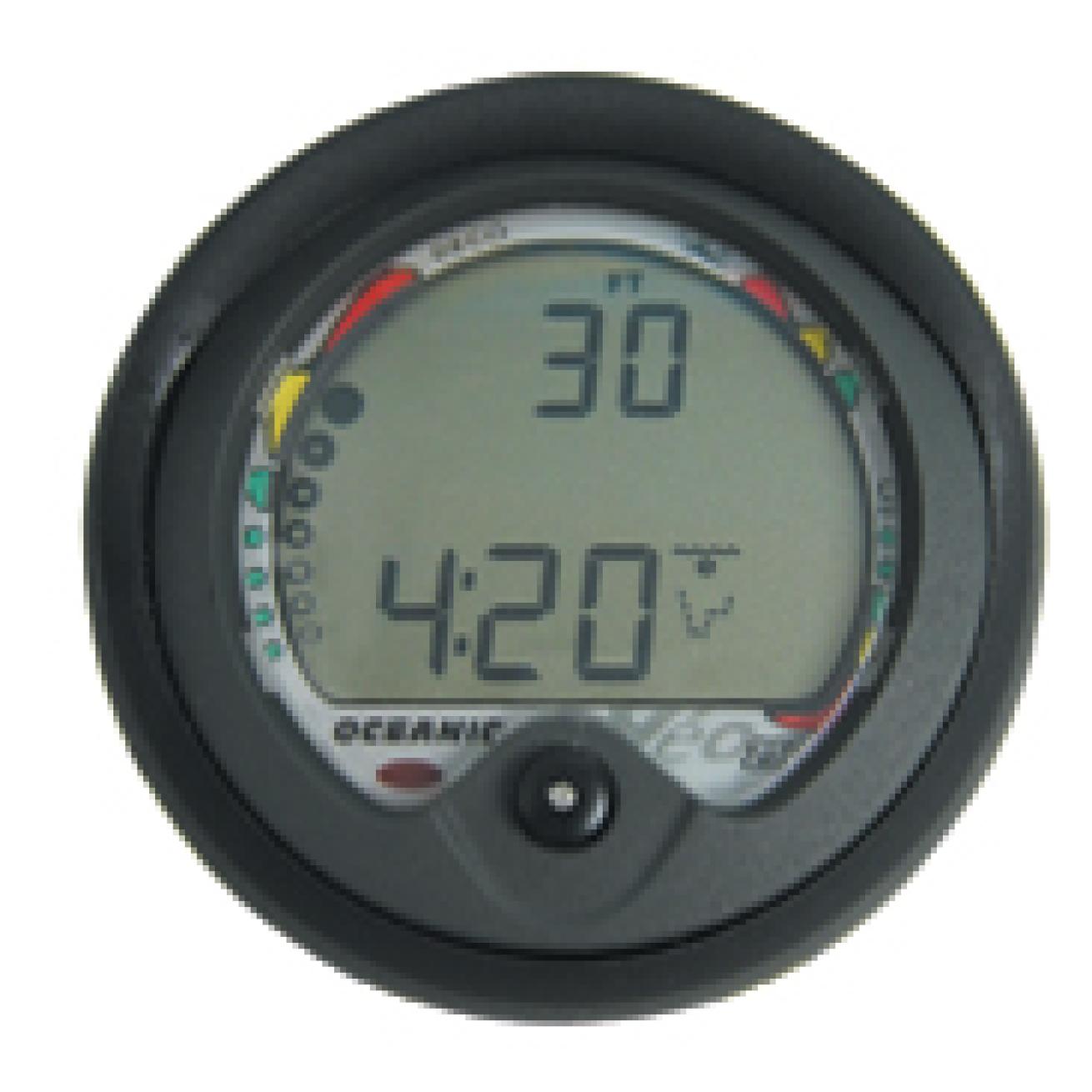
| | OCEANIC Veo 250|
Overall, test divers liked the performance and presentation of data of the Veo 250 via its four dive mode screens. Commented one diver, "The alternate screens are easy to understand and to access at depth, and I like the simple logbook function on the surface." However, this same diver found the clear plastic screen protector "a bit hard to see through right after you get out of the water." These protectors snap onto the screen face and are easy to remove. Another test diver found it very easy to program in personal preferences: "It's very intuitive. Button controls are easy to use, putting all relevant data right at hand."
{mospagebreak} SHERWOOD Profile

| | SHERWOOD Profile| Sherwood's Profile is a keep-it-simple dive computer incorporating a single push-button control, green-yellow-red bar graphs and good-sized numbers set in an orderly display. While universally lauded as an efficient, easy-to-use dive computer, this simplicity appealed to only half the test divers--in particular, those who aren't that familiar with computers.
The Profile has an owner's manual that is simple and straightforward and easy even for the neophyte computer user to understand. The computer itself was described as "very functional." One test diver, who prefers simplicity, added, "This is a very readable computer. I found it very easy to understand, even on the first dive."
But the more computer-savvy divers felt that while the Profile performed well as a basic computer, it was just too limiting for their tastes. Said one such diver, "This is a simple, easy-to-use computer, but the one-button control is just not enough." Preferring a computer with more programming capability, he added, "For me, this would be a really good backup computer."
SUUNTO Gekko
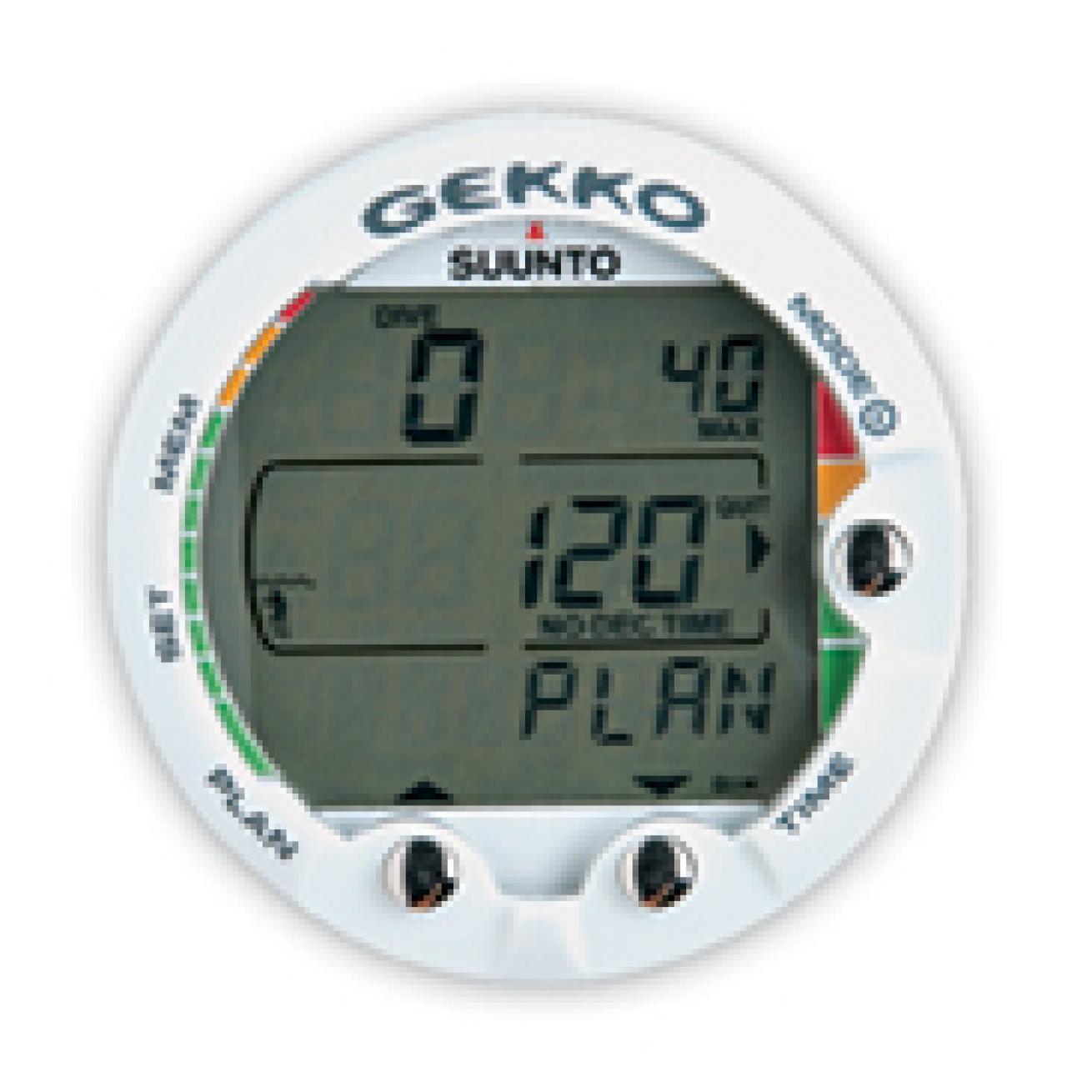
| | SUUNTO Gekko| The Gekko is based on Suunto's popular Vyper and Cobra dive computers, without a number of their features and at a much lower price. What you get with the Gekko is a wafer-thin, well-laid-out display with big bold numbers, helpful graphics and green-yellow-red color bars to simplify data monitoring. What you don't get is a PC interface or an electronic backlight function. To provide illumination you can charge the computer's phosphorescent LCD display by shining a dive light on it.
Contributing to what test divers considered to be an excellent data screen both on the surface and at depth, the Gekko lets you know exactly what mode you're in by plainly telling you-- "history," "memory," "nitrox," etc. appear prominently in the lower corner of the screen, a huge convenience. Grouping similar functions into a single section also simplifies the menu system, creating a more intuitive computer requiring fewer button pushes to get where you want to go.
This is the most programmable computer of the group, allowing you to adjust for three altitude ranges as well as three personal preference ranges. This will make a computer that already leans toward the conservative even more so.
As one test diver commented, "This is a great, safe, easy-to-understand computer. Simple for the beginner, but with all the features that a pro might need." Another diver added, "An outstanding computer, simply no complaints--except for the lack of a backlight."
TUSA IQ-700 Hunter
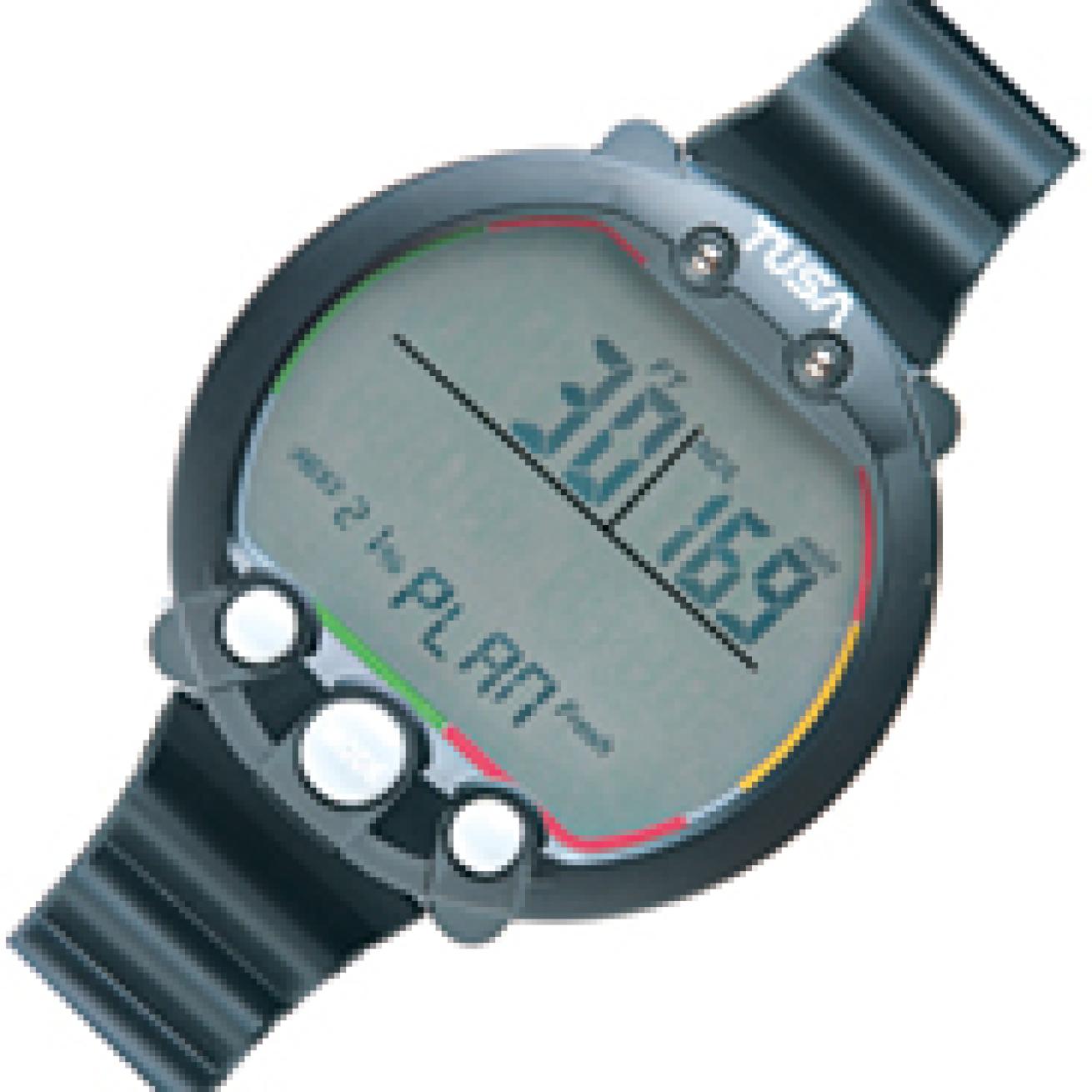
| | TUSA IQ-700 Hunter| Tusa's IQ-700 Hunter is another computer that uses a well-designed display with "dive," "plan," "log" and other prompts to let you know what screen you're working in. The computer has a large center mode button flanked by smaller buttons that make it easy to navigate through the system. The computer uses green-yellow-red bar graphs, but they are very narrow and difficult to see, especially at depth. Data digits are good-sized and easy to read. A safety factor adjustment allows you to program an additional level of conservatism into your dive.
Overall, test divers liked the Hunter. It garnered positive comments for ease of accessing and reading screens both on the surface and at depth. As one diver said, "It's easy to get the info you need at depth--also easy to read after-dive data. Plus, the manual is easy to follow." Other test divers liked the alarm that sounds as you're about to hit the red NDL zone. However, most test divers griped about having to hold down the button to view the alternate screen. Echoing the sentiments of others, one diver said, "I'd rather just hit the button once and let it go."
Standard Features
Important convenience features once so elusive in dive computers can now be found on virtually every model in this group. For example:
> WATER ACTIVATION. All of these computers will turn themselves on upon hitting the water.
> REPLACEABLE BATTERIES. The lithium batteries used in most of today's computers cost just a few bucks apiece, can be found in most electronics stores and are relatively easy to change. Dacor and Mares make it even easier--their computers use AAA batteries you can buy with your spare change, and their watertight compartments are super simple to access, allowing you to switch out batteries virtually in seconds.
> VARIABLE ASCENT ALARMS. All but the Citizen Aqualand Nx allow for faster ascents at greater depths (60 feet per minute in depths greater than 60 feet), then slow you down as you reach shallower depths (30 feet per minute in depths shallower than 60 feet). The Aqualand Nx allows a uniform rate of 60 feet per minute.
> BACKLIGHTS. All these dive computers except the Aqualand Nx provide some way to illuminate the data screen at night, although some are easier to use and more efficient than others. The Citizen's light function is designed to enhance daylight viewing, only.
> NITROX CAPABILITIES. All but the entry-level Genesis Resource are capable of calculating nitrox mixes up to 50 percent. The Tusa IQ-700 Hunter calculates nitrox mixes to 99 percent.
> AUDIBLE ALARMS. All but the Genesis Resource and Sherwood Profile provide disarmable audible alarms. All of these computers also have some sort of visual alarms, from LED lights to blinking bar diamonds and flashing data digits.
> PC CONNECTIVITY. All but the Genesis Resource and Suunto Gekko offer the ability to download dive data to your personal computer. The Gekko does, however, have a PC port that allows dive shops to zero out the computer between rentals.
> DATE/TIME AND TEMPERATURE. All of these computers provide water temperature. All also offer date, time or both.
The Differences
It's the details that differentiate these computers from each other. For example:
> DATA DISPLAYS. How a computer presents its diving information can make a big difference. Some computers display the most critical data (like NDLs and depth) with the largest digits, followed by the less critical data (like temperature and time) with smaller digits. Other computers use similar sized digits for all data, and on others there seems to be no correlation between the importance of data and the size of digits.
> ALGORITHMS. A computer's algorithm determines its liberal or conservative leanings. Conservative algorithms limit the amount of time you can spend at depth without putting the computer into deco mode, but increase your safety margin. Liberal algorithms allow more bottom time before going into deco mode, leaving it to the diver to factor in a DCS cushion.
> AIR INTEGRATION. Some of these computers provide tank pressure data, using either a console design that connects to a high-pressure hose, or a "wireless" or "hoseless" system that uses a transmitter screwed into your first stage.
> DATA AND/OR SCREEN ACCESS. Depending on computer, you have from one to four buttons with which to access data, program preferences or switch screens. In most cases, the more buttons a computer has, the easier it is to use.
> COLOR HIGHLIGHTS AND/OR GRAPHICS. Nitrogen-loading and ascent rate bars using green, yellow, red color schemes make information much easier to read and understand. Graphics also draw attention to critical data, and word or icon prompts allow you to immediately discern what mode you're in.
Fashionably Late
Here's a first look at three new computers unavailable during our tests but now hitting the U.S. market. Look for full reports in a future issue.
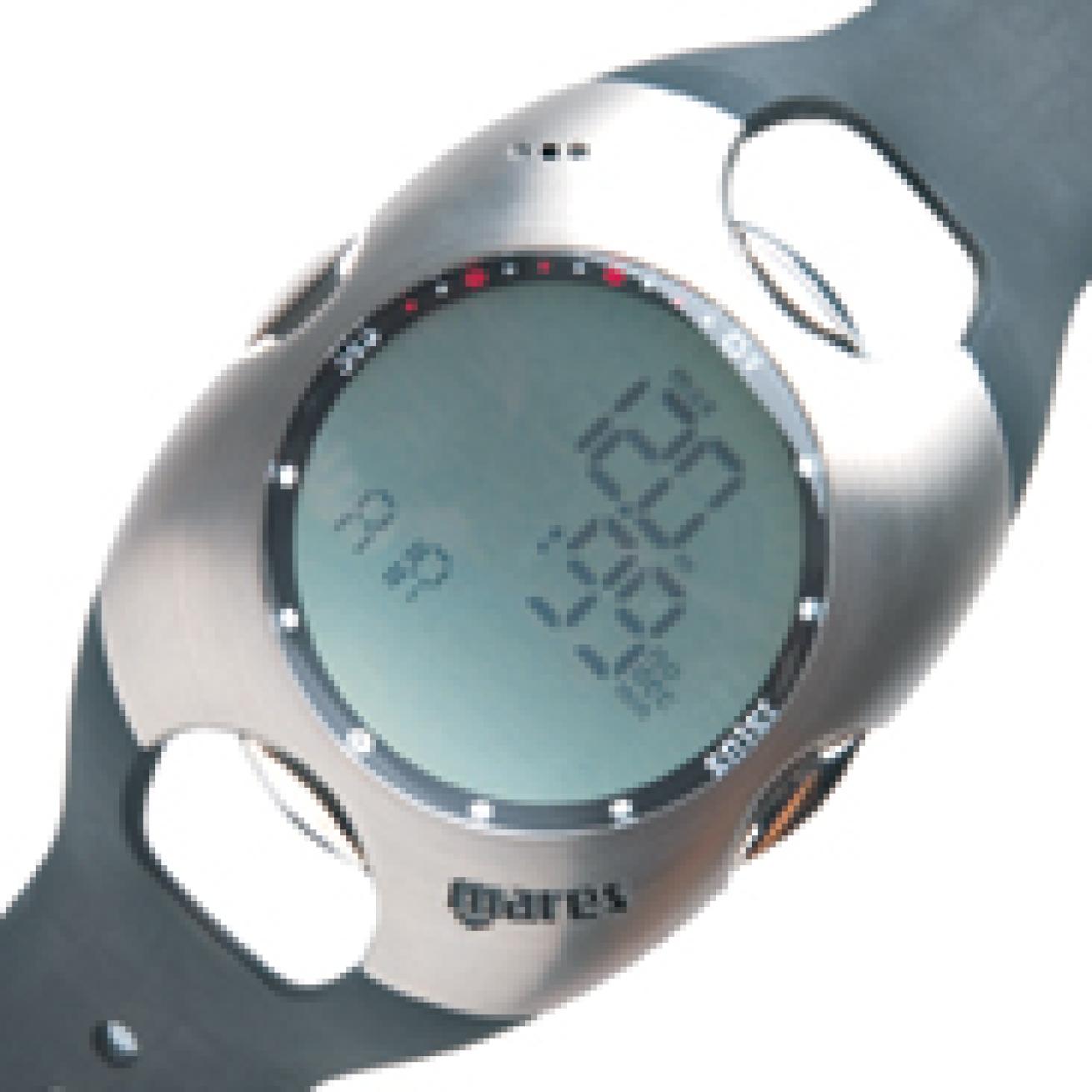
| MARES Nemo|
> MARES Nemo. This stylish, Euro-designed dive computer/wristwatch combo is available in a brushed stainless-steel or titanium casing with a composite rubber wristband. It uses Mares' new RGBM algorithm and it's suited for both air and nitrox mixes.

| OCEANIC Atom 1.0|
> OCEANIC Atom 1.0. Oceanic's first wristwatch/computer combo is air-integrated, offers eight different screens and can be programmed for up to three nitrox mixes. OceanLog PC software lets you download dives and upload settings.
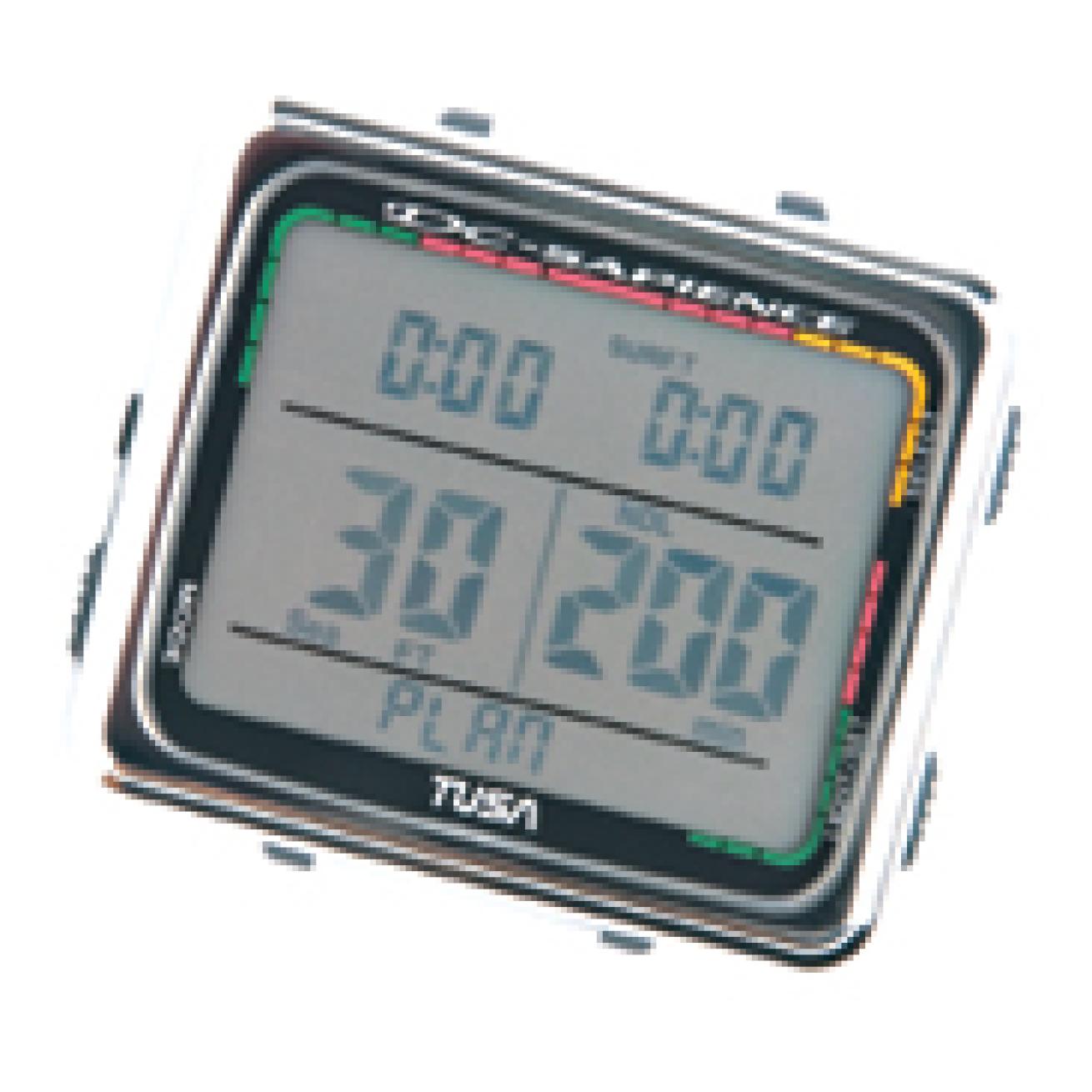
| TUSA IQ-800|
> TUSA IQ-800. The sleek IQ-800 DC-Sapience generates a lot of buzz, thanks to its uncluttered layout and unique vibration warning function, similar to what you'd find on a cellular phone.
Liberal or Conservative?
How your computer's algorithm affects your bottom time
By John Francis
Our dive computer tests don't stop with the size of the buttons and the readability of the displays. We also test the information they give you about your no-decompression limits (NDLs) because computers can differ significantly on the exact same profile.
To test these differences, we put all 11 dive computers in the USC Hyperbaric Chamber on Catalina Island and ran them simultaneously on a three-dive profile designed to represent a typical day of multilevel dives within recreational limits.
The first dive, for 51 minutes, went to a maximum depth of 100 feet. After a one-hour surface interval we made a second dive of 44 minutes to a max depth of 70 feet. An hour-and-a-half surface interval followed before the third dive, 41 minutes to a max depth of 60 feet. Just to make it interesting, the second dive included a reverse profile--five minutes at 40 feet, four minutes at 60 feet, then five minutes at the max depth for 70 feet. On the ascent we had our "divers" spend six minutes at 60 feet and seven minutes at 40. Ascent rates did not exceed 30 feet per minute.
Our liberal-vs.-conservative charts note the minutes of no-deco time each computer allowed at specific moments in each dive. These differences are the result of the algorithms used to calculate NDLs.
Are the most liberal computers reckless? Are the most conservative paranoid? There's no way to be sure, given the theoretical nature of decompression and individual factors such as fitness, cold, exertion levels and hydration. Ultimately, you must decide what constitutes a safe profile and build in safety margins.
Algorithm Soup
An algorithm, in this context, is your dive computer's program. It's the complex mathematics behind someone's theory of how decompression works. The computers in this review use four base algorithms--usually tweaked and modified to varying degrees by manufacturers--based on four different theories of how a diver absorbs and eliminates inert gases.
THE BASE ALGORITHM: Haldanean
Based on the work of J.S. Haldane, the pioneer of decompression theory, these algorithms have been modified numerous times over the years and remain the most widely used in diving. Haldane's theory grouped the body's thousands of different tissues into theoretical tissue compartments, each with a different rate for absorbing and releasing inert gas. He also believed that gas was always released at the same rate at which it was absorbed. The theory does not account for the presence of tiny "silent bubbles" formed during ascent that can slow off-gassing, so Haldanean algorithms, unless specifically modified, tend to be very liberal in adding no-decompression time during ascents.
The Computers: Aeris Atmos Elite, Genesis React Pro, Genesis Resource Pro, Oceanic VT Pro, Oceanic Veo 250, Sherwood Profile.
The Results: In our tests, these six computers allowed the most consistently liberal no-deco times from start to finish and consistently added no-decompression time during ascents--even after the reverse profile.
THE BASE ALGORITHM: DCIEM
Developed by the Canadian Defense and Civil Institute of Environmental Medicine (DCIEM), this algorithm is unusual because it assumes only four tissue compartments and because it assumes that dissolved gas passes from your blood to your fastest tissue, and from it to the next fastest, and so on. Haldane and other theories assume gas passes from blood to each compartment directly.
The Computer: Citizen Aqualand Nx.
The Result: During our chamber dives, the Citizen was very conservative at maximum depths, but also very liberal during the later portions of ascents, sometimes even more liberal than Haldanean computers. On ascent from the reverse profile in Dive 2, it went from the most conservative computer to the most liberal. The Citizen initially subtracted no-deco time (from seven minutes at 70 feet, to three minutes at the 60-foot sampling point), but after seven minutes at 40 feet it was displaying a generous 66 minutes of no-deco time.
THE BASE ALGORITHM: Buhlmann
Swiss researcher Albert Buhlmann added to the Haldanean model the idea behind "M values" developed by Robert Workman. These values represent the theoretical amount of overpressure that tissues can tolerate without forming bubbles. Buhlmann also gave more attention to slower tissues.
The Computer: Tusa IQ-700 Hunter.
The Results: The Tusa consistently staked the middle ground between the most liberal and most conservative computers, but trended to the conservative side. On ascent from the reverse profile, it initially subtracted no-deco time (from 13 minutes at 70 feet to 10 minutes at 60 feet), but then tended to hold steady. On ascent from 40 feet, it added time, but not as rapidly as the Haldanean or DCIEM computers.
THE BASE ALGORITHM: RGBM
The Reduced Gradient Bubble Model (RGBM) algorithm was developed after Doppler bubble research showed that "silent bubbles" unknown to Haldane often form after a dive without causing DCS symptoms. On the theory that these bubbles would be slower than dissolved gas to leave your body, and could even interfere with the outflow of dissolved gas, the algorithm is consistently conservative.
The Computers: Dacor Darwin Air, Mares M1 RGBM, Suunto Gekko.
The Results: These computers started conservative, stayed that way longer during ascents and tended to go even more conservative in their initial response to the reverse profile. At our sample points on the ascent from Dive 2, they had subtracted no-deco time when some of the more liberal computers had added it. One RGBM computer even ran out of no-deco time after a seven-minute stay at 40 feet. Haldanean computers at the same moment allowed 57 minutes, the DCIEM computer 66 minutes. On ascent from 40 feet, they all began to add no-deco time. With an RGBM computer, particularly on a reverse profile, you cannot dive to the edge of the no-deco limits and then assume a modest ascent will buy you more time.


